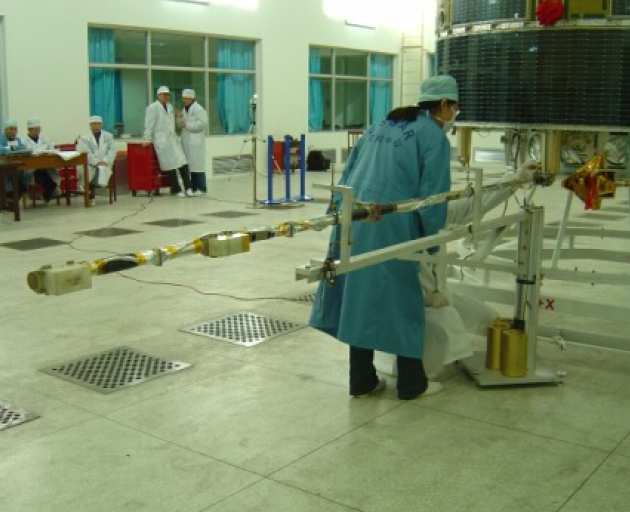Removing spacecraft interference
The dual magnetometer setup
A typical design set up for a space based dc magnetometer experiment is to mount a primary sensor near the end of a boom and a secondary sensor between this outboard sensor and the spacecraft. A boom is used to hold the sensors as far as possible from the spacecraft body in order to minimise magnetic interference from the spacecraft operation. The use of two separate sensors in the design is primarily done for redundancy with the primary sensor sampling vectors at a much higher rate than the secondary sensor. However if both sensors sample at the sme rate(often included as a telemetry mode) it also opens up the option of using a dual magnetometer technique such as that described by Ness et al.(1971). The dual magnetometer method allows an estimate through time to be made of the spacecraft generated field. This means that in cases where the spacecraft field is a significant interference to the measured scientific signal the dual magnetometer method can be used to remove unwanted field.
A case study: The Double Star mission
 In the case of the Double Star mission, the spacecraft TC-1 was found to generate a significant spacecraft field once in-flight which has been a major contaminant to the scientific signal. The dual magnetometer set up has been essential for the purpose of decontaminating the magnetometer data. Full details of the determination of the spacecraft field for TC-1 and how this is applied in cleaning the data can be found in Carr et al.(2005). It is demonstrated in Carr et al.(2005), by first assuming the spacecraft field to be a dipole and the ambient field to be the same value at both sensors, that the difference between the measured inboard and outboard magnetic field is related to the outboard spacecraft field by a constant. This is shown in equation 1 where Bos is the outboard spacecraft field, Bit is the total(ambient plus spacecraft) or measured inboard field, Bot is the total outboard field and ko is a constant. A similar expression can be written to determine the inboard spacecraft field where the proportionality constant is a different value.
In the case of the Double Star mission, the spacecraft TC-1 was found to generate a significant spacecraft field once in-flight which has been a major contaminant to the scientific signal. The dual magnetometer set up has been essential for the purpose of decontaminating the magnetometer data. Full details of the determination of the spacecraft field for TC-1 and how this is applied in cleaning the data can be found in Carr et al.(2005). It is demonstrated in Carr et al.(2005), by first assuming the spacecraft field to be a dipole and the ambient field to be the same value at both sensors, that the difference between the measured inboard and outboard magnetic field is related to the outboard spacecraft field by a constant. This is shown in equation 1 where Bos is the outboard spacecraft field, Bit is the total(ambient plus spacecraft) or measured inboard field, Bot is the total outboard field and ko is a constant. A similar expression can be written to determine the inboard spacecraft field where the proportionality constant is a different value.
Bos=ko(Bit-Bot ) (1)
TC-1 operates in several different power shunting modes which result in several different generated spacecraft field values. It is possible to use the measured field differences between these shunting levels to determine the constant ko which then makes it possible to determine the spacecraft field. In addition, on TC-1 a new data acquisition mode has been implemented called gradiometer mode. This mode acquires vectors from both the primary and secondary sensors at the same data rate which is half the normal science data rate from the primary sensor. This allows a more accurate determination of the spacecraft field. To see a comparison of cleaned and uncleaned TC-1 data click here.
Carr, C. et al., The Double Star magnetic field investigation: instrument design, performance and highlights of the first year's observations, Ann. Geophys., 23, 2713-2732, 2005.
Ness, N. F., Behannon, K. W., Lepping, R. P., and Schatten, K. H., Use of two magnetometers for magnetic field measurements on a spacecraft, J. Geophys. Res., 76, 3565-3573, 1971.